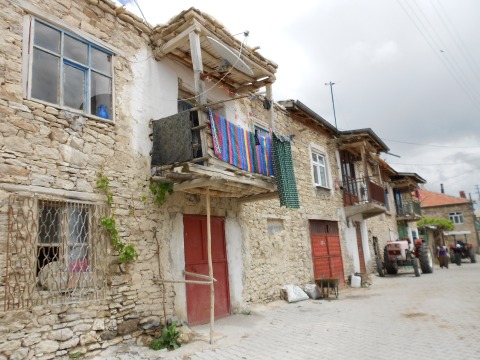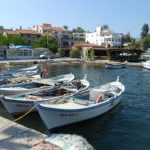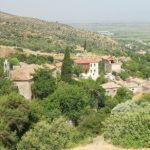My taxi driver is not in a good mood. He doesn’t want to take me to Fasıllar, inland from Lake Beyşehir, because, he says, it will be muddy. On the other hand he doesn’t want to refuse outright either and risk losing the fare. We set off, then, in a stony silence which it takes a very long time and a visit to the Hittite remains at Eflatunpınar to break.
The road to Fasillar starts out as well as any other and it’s only when we near the village that I realise that he may have had a point after all. A dirt road zigzags up from in front of it. “You see? There’s no tarmac. In winter it’s dreadful.”
“Yes, but how many people actually come here? The highways people are widening the road round to Kubadabad (on the opposite side of the lake) and building a new one to Antalya. They can’t be everywhere at once.”
“Lots of people come here. Lots. You’ll see. Those people (a minibus full of Germans) who were at Eflatunpınar, they’ll be coming here too.”
But already I’m starting to zone out his complaints in favour of gazing in admiration at the rocky valley into which we’re driving. Off on the right I can see something wonderful – the Atlıkaya, a Graeco-Roman monument to a young man named Lucien which comes with an amazing relief carving of a horse in decorative finery. Further up the valley I spot another carving decorated with a small bust, presumably of the deceased. These are remains of the lost city of Misthia, although what had actually brought me here is something lying on the other side of the valley, namely a huge Hittite carving that may have been intended to stand on top of the shrine at Eflatunpınar. In its prone position it’s virtually impossible to make out any details. Luckily there’s a copy standing upright outside the Museum of Anatolian Civilisations in Ankara.
By now the driver is starting to warm up and even deigns to point out another Greek inscription on a rock by the roadside. I don’t dare suggest diverting into Fasıllar, a small settlement of solid stone houses with corrugated-iron roofs set around a modern mosque, but as we drive back through neighbouring Çiçekler (Flowers) I pluck up the courage to mention çay.
Çay! The great Turkish ice-breaker! No, Mustafa doesn’t know if there’s a teahouse in the village but he’s happy to divert to make enquiries which is how we end up sitting in front of the local bakkal with two grandfathers clad in bobblehats and clutching walking sticks that look to have been hewn from bare branches. One is 82, the other 83, and they’re more than ready for a chat about the village.
Pancar (sugarbeet), that’s the life-blood of the village, they tell me. It’s harvested in November, or, as they tell me in quaint village-style, in the eleventh month.
“It’s so quiet here,” I say dreamily, meaning of course that there are almost no intrusive sounds to disturb the peace.
“Yes,” replies one of the granddads. “Everybody has gone to Konya to elect a new member of the Pancar Co-operative Board.”
“Who buys the beet? Does it all stay in Turkey?”
“No, some of it is exported. But most is bought by Konya Şeker (the company, I remember, who have been sponsoring the reafforestation of roadsides in all directions out of Konya). It used to be a government monopoly but now it’s privatised. It’s much better now. It runs much more efficiently. And they don’t just deal with sugar either now – they’re into crisps and chocolate too.”
The çay is a long time coming so I take a quick turn around the village which, like Fasıllar, boasts some sturdy stone houses, at least one of them reusing what look like pieces of Byzantine carving in the masonry. I pause in wonder in front of a fountain that also appears to have borrowed from the Byzantines. Alongside it trails a line of huge, partially shaped blocks which I’m pretty sure must date back to the Hittites.
Over tea the elders tell me that local children can go to school in the village up to fourth grade but then have to be bused out to a bigger settlement. Behind us in the road slabs of stone are piled up. New side streets are about to be laid here; change is on its way.
As we leave Çiçekler an oil tanker is pulling in. “They bring fuel here now. They never used to,” says Mustafa who seems much perkier after refreshment.
“Apples,” he points out as we zoom back along the road to Beyşehir. “Plums.”
By the time we get back to the hotel he’s even cheered up enough to mention the mosque in Seydişehir to me. “It was built at the same time as the Eşrefoğlu Cami,” he says which means at the turn of the 14th century.
And I’d never heard of it. Shame on me. 
Written: 25 June 2013


